Detailed Business Finance Report: ASX, NSX, and Financial Products
VerifiedAdded on 2023/01/12
|8
|1588
|23
Report
AI Summary
This report provides a comprehensive overview of business finance, focusing on the Australian Securities Exchange (ASX) and the National Stock Exchange (NSX). It begins by outlining the listing requirements for companies on both exchanges, including shareholder minimums, free float percentages, and financial performance criteria. The report then delves into the types of indices listed on each exchange, such as the S&P/ASX technology index and sector indices, and explains their importance for investors in benchmarking performance and gauging market volatility. Following this, the report details various financial products traded on the ASX, including shares, exchange-traded options (call and put), and warrants, along with their features and subcategories. The report also provides a historical overview of the ASX, its evolution, industry categorization based on global standards, and the number of listed companies. The conclusion emphasizes the role of securities exchanges in maximizing company wealth, the significance of listing requirements, and the benefits of trading on specific indices, highlighting the services offered by ASX and NSX to companies and intermediaries.

Business Finance
Paraphrase This Document
Need a fresh take? Get an instant paraphrase of this document with our AI Paraphraser
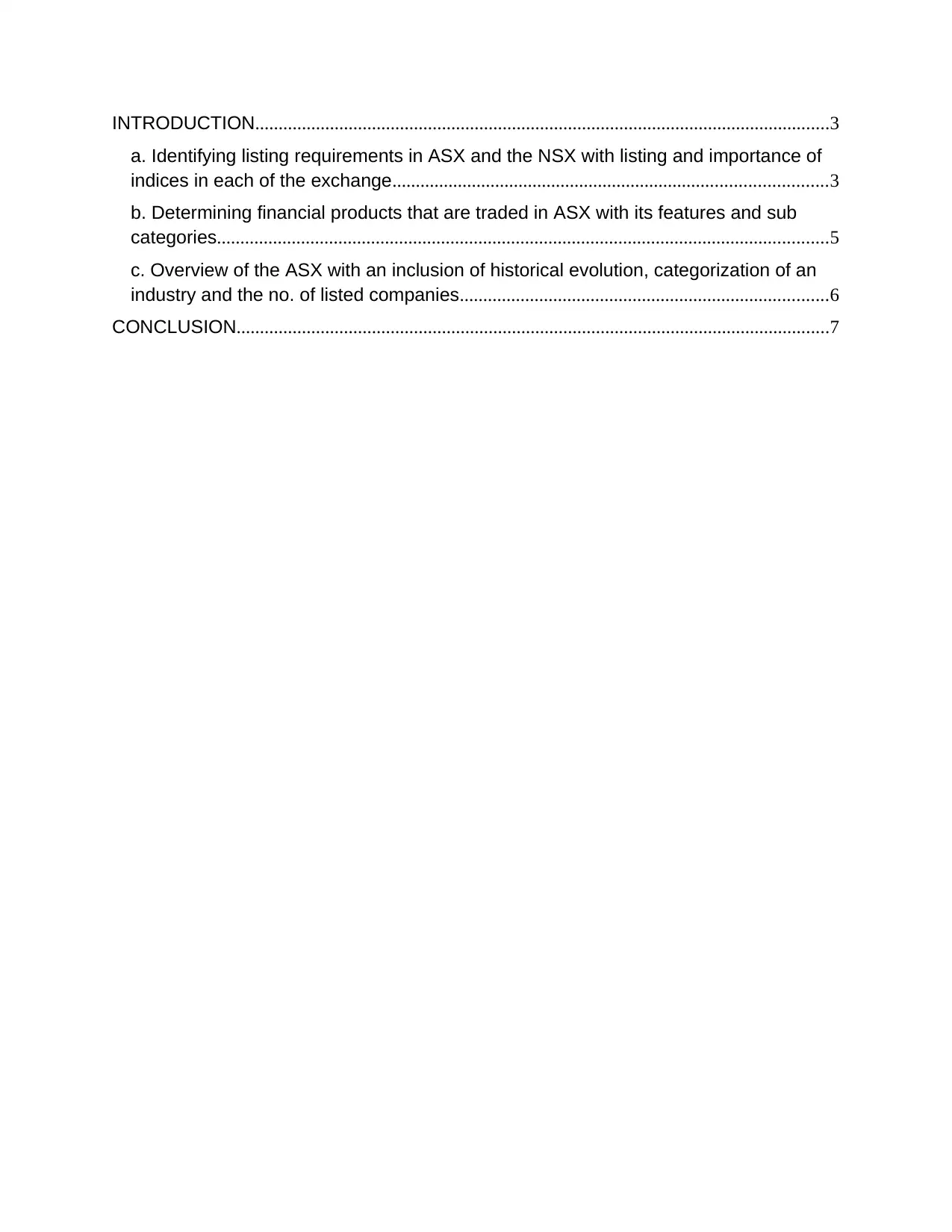
INTRODUCTION...........................................................................................................................3
a. Identifying listing requirements in ASX and the NSX with listing and importance of
indices in each of the exchange.............................................................................................3
b. Determining financial products that are traded in ASX with its features and sub
categories...................................................................................................................................5
c. Overview of the ASX with an inclusion of historical evolution, categorization of an
industry and the no. of listed companies...............................................................................6
CONCLUSION...............................................................................................................................7
a. Identifying listing requirements in ASX and the NSX with listing and importance of
indices in each of the exchange.............................................................................................3
b. Determining financial products that are traded in ASX with its features and sub
categories...................................................................................................................................5
c. Overview of the ASX with an inclusion of historical evolution, categorization of an
industry and the no. of listed companies...............................................................................6
CONCLUSION...............................................................................................................................7
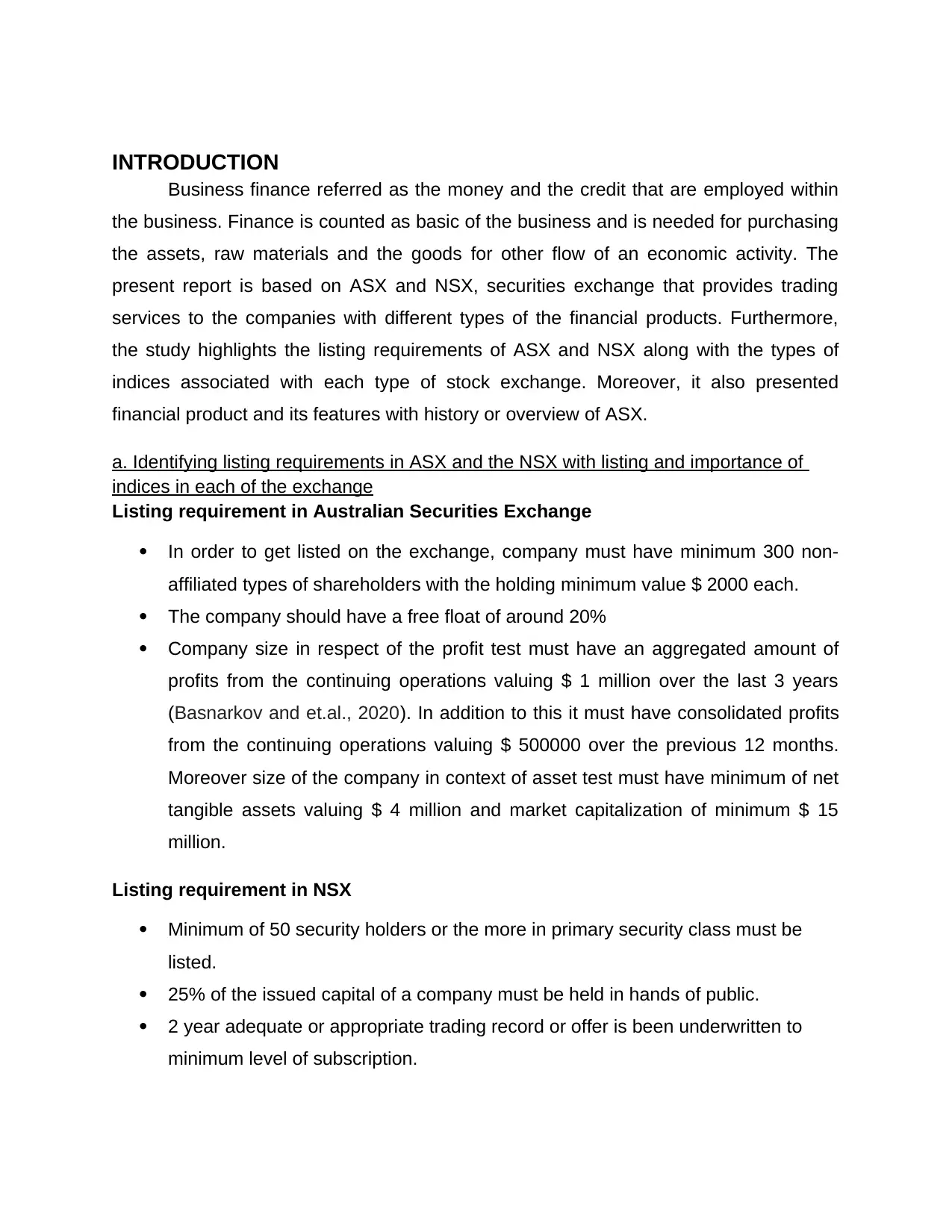
INTRODUCTION
Business finance referred as the money and the credit that are employed within
the business. Finance is counted as basic of the business and is needed for purchasing
the assets, raw materials and the goods for other flow of an economic activity. The
present report is based on ASX and NSX, securities exchange that provides trading
services to the companies with different types of the financial products. Furthermore,
the study highlights the listing requirements of ASX and NSX along with the types of
indices associated with each type of stock exchange. Moreover, it also presented
financial product and its features with history or overview of ASX.
a. Identifying listing requirements in ASX and the NSX with listing and importance of
indices in each of the exchange
Listing requirement in Australian Securities Exchange
In order to get listed on the exchange, company must have minimum 300 non-
affiliated types of shareholders with the holding minimum value $ 2000 each.
The company should have a free float of around 20%
Company size in respect of the profit test must have an aggregated amount of
profits from the continuing operations valuing $ 1 million over the last 3 years
(Basnarkov and et.al., 2020). In addition to this it must have consolidated profits
from the continuing operations valuing $ 500000 over the previous 12 months.
Moreover size of the company in context of asset test must have minimum of net
tangible assets valuing $ 4 million and market capitalization of minimum $ 15
million.
Listing requirement in NSX
Minimum of 50 security holders or the more in primary security class must be
listed.
25% of the issued capital of a company must be held in hands of public.
2 year adequate or appropriate trading record or offer is been underwritten to
minimum level of subscription.
Business finance referred as the money and the credit that are employed within
the business. Finance is counted as basic of the business and is needed for purchasing
the assets, raw materials and the goods for other flow of an economic activity. The
present report is based on ASX and NSX, securities exchange that provides trading
services to the companies with different types of the financial products. Furthermore,
the study highlights the listing requirements of ASX and NSX along with the types of
indices associated with each type of stock exchange. Moreover, it also presented
financial product and its features with history or overview of ASX.
a. Identifying listing requirements in ASX and the NSX with listing and importance of
indices in each of the exchange
Listing requirement in Australian Securities Exchange
In order to get listed on the exchange, company must have minimum 300 non-
affiliated types of shareholders with the holding minimum value $ 2000 each.
The company should have a free float of around 20%
Company size in respect of the profit test must have an aggregated amount of
profits from the continuing operations valuing $ 1 million over the last 3 years
(Basnarkov and et.al., 2020). In addition to this it must have consolidated profits
from the continuing operations valuing $ 500000 over the previous 12 months.
Moreover size of the company in context of asset test must have minimum of net
tangible assets valuing $ 4 million and market capitalization of minimum $ 15
million.
Listing requirement in NSX
Minimum of 50 security holders or the more in primary security class must be
listed.
25% of the issued capital of a company must be held in hands of public.
2 year adequate or appropriate trading record or offer is been underwritten to
minimum level of subscription.
⊘ This is a preview!⊘
Do you want full access?
Subscribe today to unlock all pages.

Trusted by 1+ million students worldwide
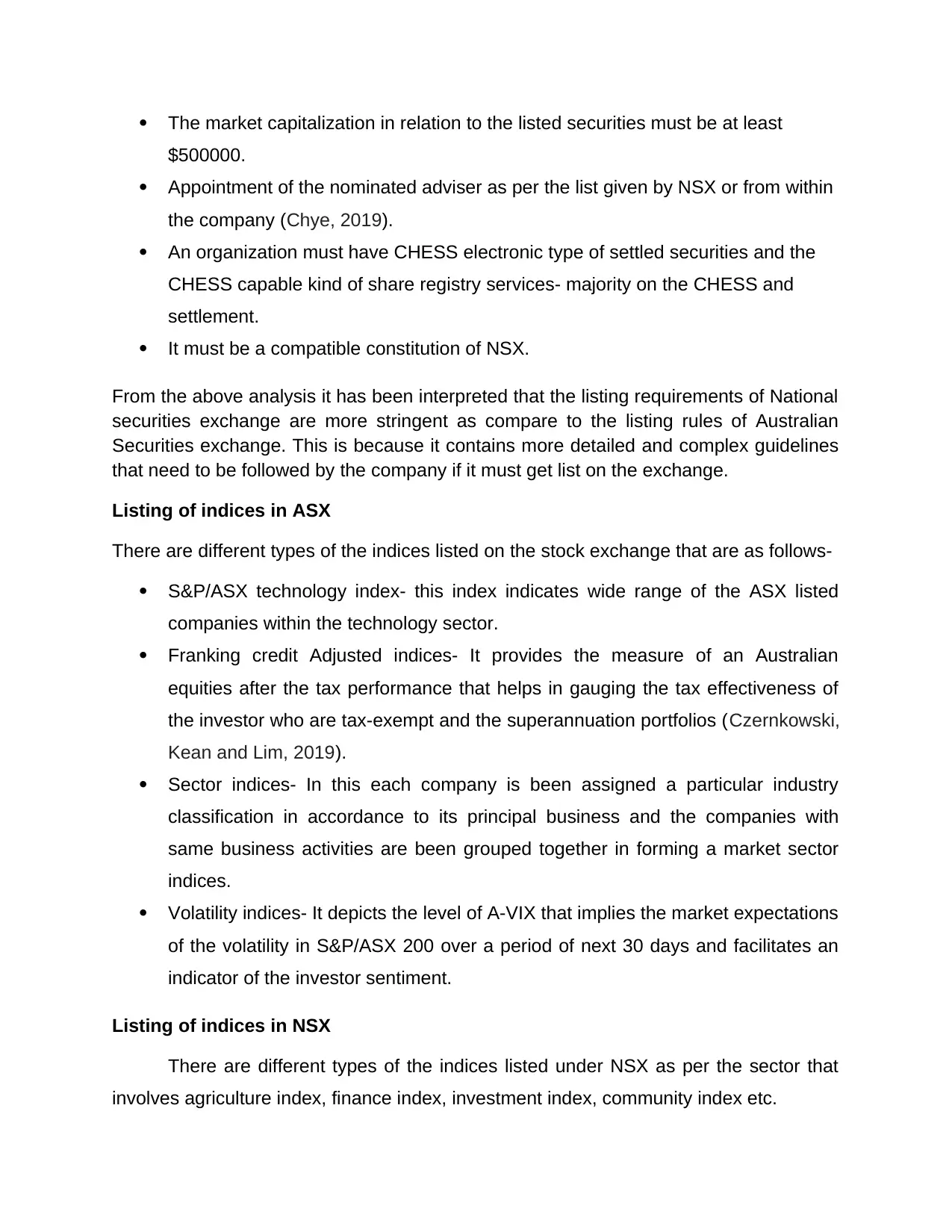
The market capitalization in relation to the listed securities must be at least
$500000.
Appointment of the nominated adviser as per the list given by NSX or from within
the company (Chye, 2019).
An organization must have CHESS electronic type of settled securities and the
CHESS capable kind of share registry services- majority on the CHESS and
settlement.
It must be a compatible constitution of NSX.
From the above analysis it has been interpreted that the listing requirements of National
securities exchange are more stringent as compare to the listing rules of Australian
Securities exchange. This is because it contains more detailed and complex guidelines
that need to be followed by the company if it must get list on the exchange.
Listing of indices in ASX
There are different types of the indices listed on the stock exchange that are as follows-
S&P/ASX technology index- this index indicates wide range of the ASX listed
companies within the technology sector.
Franking credit Adjusted indices- It provides the measure of an Australian
equities after the tax performance that helps in gauging the tax effectiveness of
the investor who are tax-exempt and the superannuation portfolios (Czernkowski,
Kean and Lim, 2019).
Sector indices- In this each company is been assigned a particular industry
classification in accordance to its principal business and the companies with
same business activities are been grouped together in forming a market sector
indices.
Volatility indices- It depicts the level of A-VIX that implies the market expectations
of the volatility in S&P/ASX 200 over a period of next 30 days and facilitates an
indicator of the investor sentiment.
Listing of indices in NSX
There are different types of the indices listed under NSX as per the sector that
involves agriculture index, finance index, investment index, community index etc.
$500000.
Appointment of the nominated adviser as per the list given by NSX or from within
the company (Chye, 2019).
An organization must have CHESS electronic type of settled securities and the
CHESS capable kind of share registry services- majority on the CHESS and
settlement.
It must be a compatible constitution of NSX.
From the above analysis it has been interpreted that the listing requirements of National
securities exchange are more stringent as compare to the listing rules of Australian
Securities exchange. This is because it contains more detailed and complex guidelines
that need to be followed by the company if it must get list on the exchange.
Listing of indices in ASX
There are different types of the indices listed on the stock exchange that are as follows-
S&P/ASX technology index- this index indicates wide range of the ASX listed
companies within the technology sector.
Franking credit Adjusted indices- It provides the measure of an Australian
equities after the tax performance that helps in gauging the tax effectiveness of
the investor who are tax-exempt and the superannuation portfolios (Czernkowski,
Kean and Lim, 2019).
Sector indices- In this each company is been assigned a particular industry
classification in accordance to its principal business and the companies with
same business activities are been grouped together in forming a market sector
indices.
Volatility indices- It depicts the level of A-VIX that implies the market expectations
of the volatility in S&P/ASX 200 over a period of next 30 days and facilitates an
indicator of the investor sentiment.
Listing of indices in NSX
There are different types of the indices listed under NSX as per the sector that
involves agriculture index, finance index, investment index, community index etc.
Paraphrase This Document
Need a fresh take? Get an instant paraphrase of this document with our AI Paraphraser
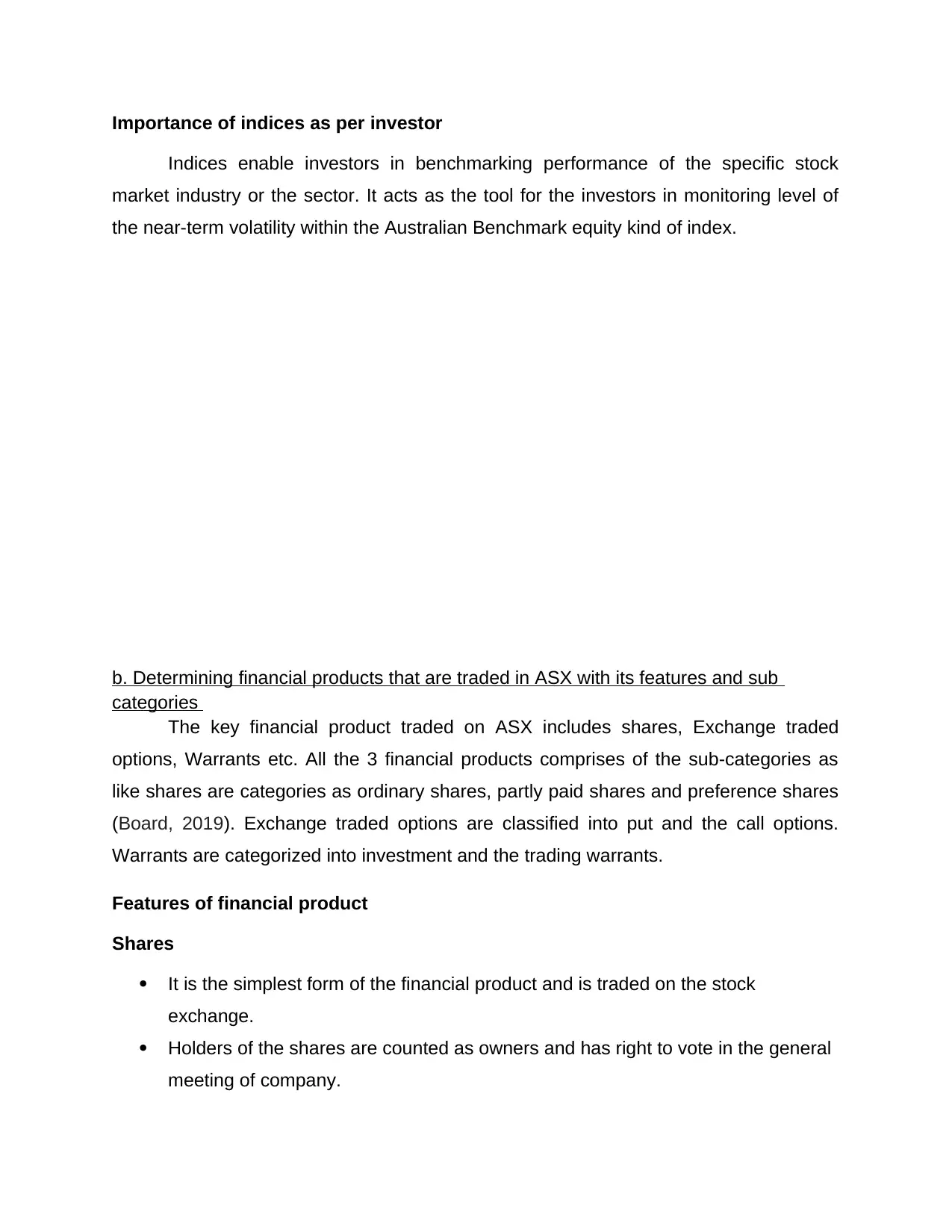
Importance of indices as per investor
Indices enable investors in benchmarking performance of the specific stock
market industry or the sector. It acts as the tool for the investors in monitoring level of
the near-term volatility within the Australian Benchmark equity kind of index.
b. Determining financial products that are traded in ASX with its features and sub
categories
The key financial product traded on ASX includes shares, Exchange traded
options, Warrants etc. All the 3 financial products comprises of the sub-categories as
like shares are categories as ordinary shares, partly paid shares and preference shares
(Board, 2019). Exchange traded options are classified into put and the call options.
Warrants are categorized into investment and the trading warrants.
Features of financial product
Shares
It is the simplest form of the financial product and is traded on the stock
exchange.
Holders of the shares are counted as owners and has right to vote in the general
meeting of company.
Indices enable investors in benchmarking performance of the specific stock
market industry or the sector. It acts as the tool for the investors in monitoring level of
the near-term volatility within the Australian Benchmark equity kind of index.
b. Determining financial products that are traded in ASX with its features and sub
categories
The key financial product traded on ASX includes shares, Exchange traded
options, Warrants etc. All the 3 financial products comprises of the sub-categories as
like shares are categories as ordinary shares, partly paid shares and preference shares
(Board, 2019). Exchange traded options are classified into put and the call options.
Warrants are categorized into investment and the trading warrants.
Features of financial product
Shares
It is the simplest form of the financial product and is traded on the stock
exchange.
Holders of the shares are counted as owners and has right to vote in the general
meeting of company.
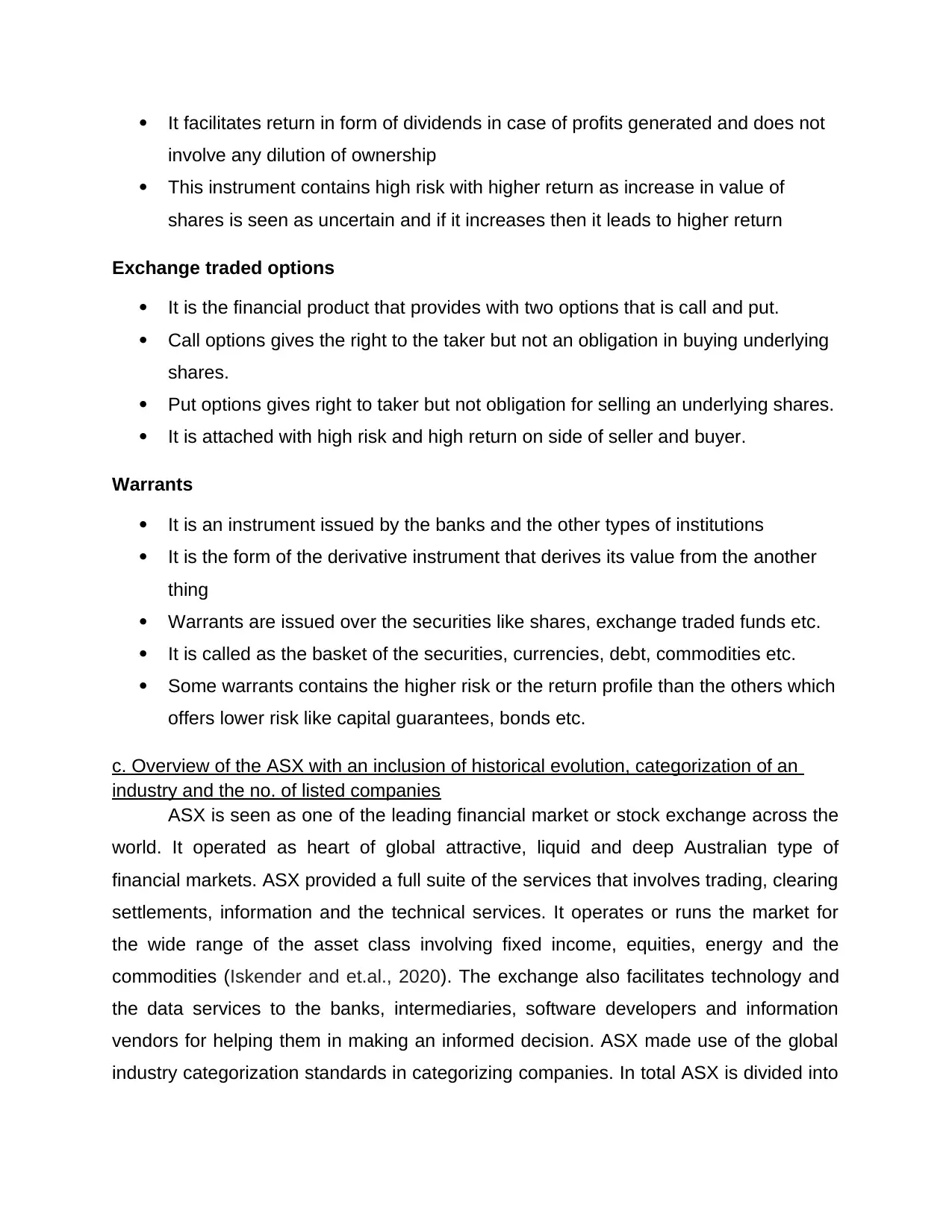
It facilitates return in form of dividends in case of profits generated and does not
involve any dilution of ownership
This instrument contains high risk with higher return as increase in value of
shares is seen as uncertain and if it increases then it leads to higher return
Exchange traded options
It is the financial product that provides with two options that is call and put.
Call options gives the right to the taker but not an obligation in buying underlying
shares.
Put options gives right to taker but not obligation for selling an underlying shares.
It is attached with high risk and high return on side of seller and buyer.
Warrants
It is an instrument issued by the banks and the other types of institutions
It is the form of the derivative instrument that derives its value from the another
thing
Warrants are issued over the securities like shares, exchange traded funds etc.
It is called as the basket of the securities, currencies, debt, commodities etc.
Some warrants contains the higher risk or the return profile than the others which
offers lower risk like capital guarantees, bonds etc.
c. Overview of the ASX with an inclusion of historical evolution, categorization of an
industry and the no. of listed companies
ASX is seen as one of the leading financial market or stock exchange across the
world. It operated as heart of global attractive, liquid and deep Australian type of
financial markets. ASX provided a full suite of the services that involves trading, clearing
settlements, information and the technical services. It operates or runs the market for
the wide range of the asset class involving fixed income, equities, energy and the
commodities (Iskender and et.al., 2020). The exchange also facilitates technology and
the data services to the banks, intermediaries, software developers and information
vendors for helping them in making an informed decision. ASX made use of the global
industry categorization standards in categorizing companies. In total ASX is divided into
involve any dilution of ownership
This instrument contains high risk with higher return as increase in value of
shares is seen as uncertain and if it increases then it leads to higher return
Exchange traded options
It is the financial product that provides with two options that is call and put.
Call options gives the right to the taker but not an obligation in buying underlying
shares.
Put options gives right to taker but not obligation for selling an underlying shares.
It is attached with high risk and high return on side of seller and buyer.
Warrants
It is an instrument issued by the banks and the other types of institutions
It is the form of the derivative instrument that derives its value from the another
thing
Warrants are issued over the securities like shares, exchange traded funds etc.
It is called as the basket of the securities, currencies, debt, commodities etc.
Some warrants contains the higher risk or the return profile than the others which
offers lower risk like capital guarantees, bonds etc.
c. Overview of the ASX with an inclusion of historical evolution, categorization of an
industry and the no. of listed companies
ASX is seen as one of the leading financial market or stock exchange across the
world. It operated as heart of global attractive, liquid and deep Australian type of
financial markets. ASX provided a full suite of the services that involves trading, clearing
settlements, information and the technical services. It operates or runs the market for
the wide range of the asset class involving fixed income, equities, energy and the
commodities (Iskender and et.al., 2020). The exchange also facilitates technology and
the data services to the banks, intermediaries, software developers and information
vendors for helping them in making an informed decision. ASX made use of the global
industry categorization standards in categorizing companies. In total ASX is divided into
⊘ This is a preview!⊘
Do you want full access?
Subscribe today to unlock all pages.

Trusted by 1+ million students worldwide
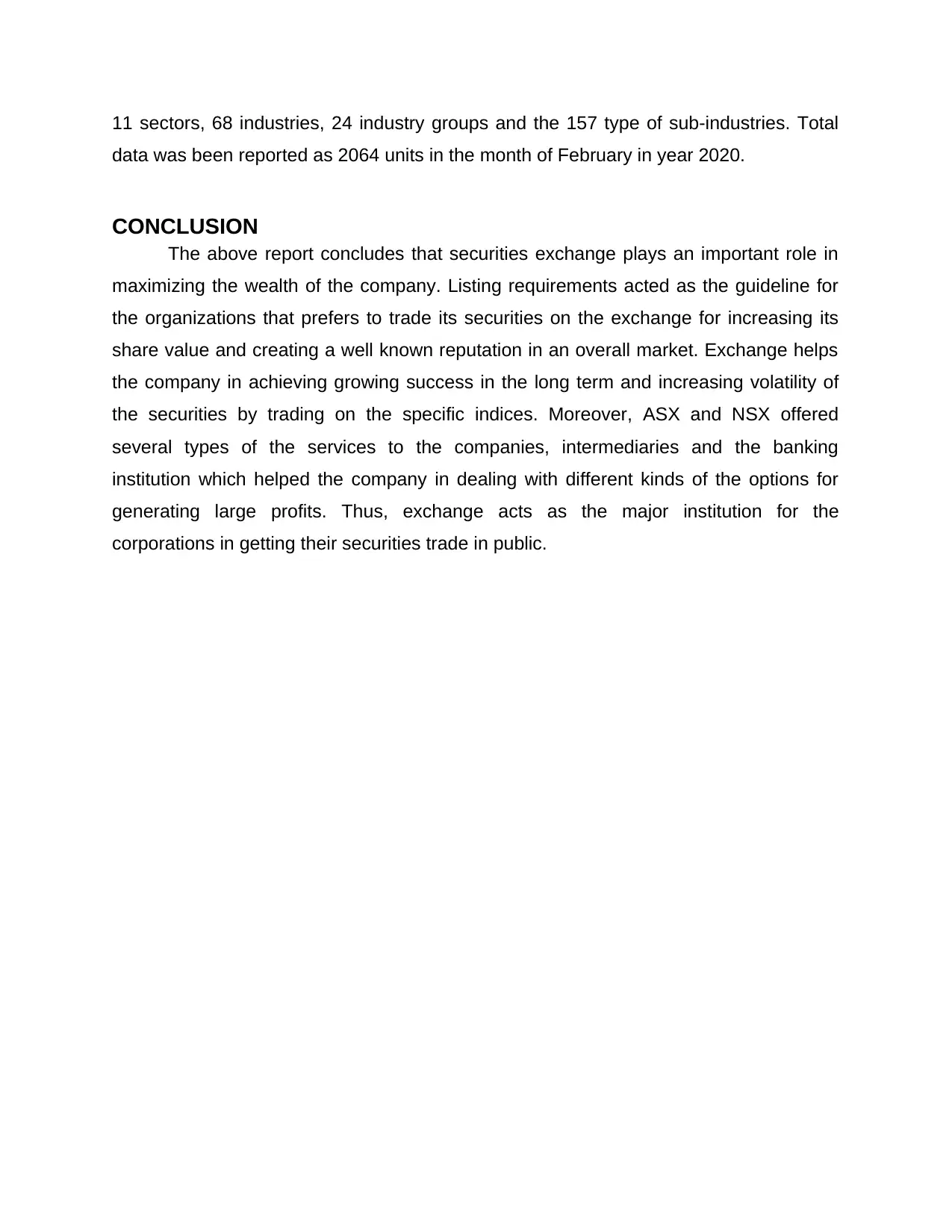
11 sectors, 68 industries, 24 industry groups and the 157 type of sub-industries. Total
data was been reported as 2064 units in the month of February in year 2020.
CONCLUSION
The above report concludes that securities exchange plays an important role in
maximizing the wealth of the company. Listing requirements acted as the guideline for
the organizations that prefers to trade its securities on the exchange for increasing its
share value and creating a well known reputation in an overall market. Exchange helps
the company in achieving growing success in the long term and increasing volatility of
the securities by trading on the specific indices. Moreover, ASX and NSX offered
several types of the services to the companies, intermediaries and the banking
institution which helped the company in dealing with different kinds of the options for
generating large profits. Thus, exchange acts as the major institution for the
corporations in getting their securities trade in public.
data was been reported as 2064 units in the month of February in year 2020.
CONCLUSION
The above report concludes that securities exchange plays an important role in
maximizing the wealth of the company. Listing requirements acted as the guideline for
the organizations that prefers to trade its securities on the exchange for increasing its
share value and creating a well known reputation in an overall market. Exchange helps
the company in achieving growing success in the long term and increasing volatility of
the securities by trading on the specific indices. Moreover, ASX and NSX offered
several types of the services to the companies, intermediaries and the banking
institution which helped the company in dealing with different kinds of the options for
generating large profits. Thus, exchange acts as the major institution for the
corporations in getting their securities trade in public.
Paraphrase This Document
Need a fresh take? Get an instant paraphrase of this document with our AI Paraphraser
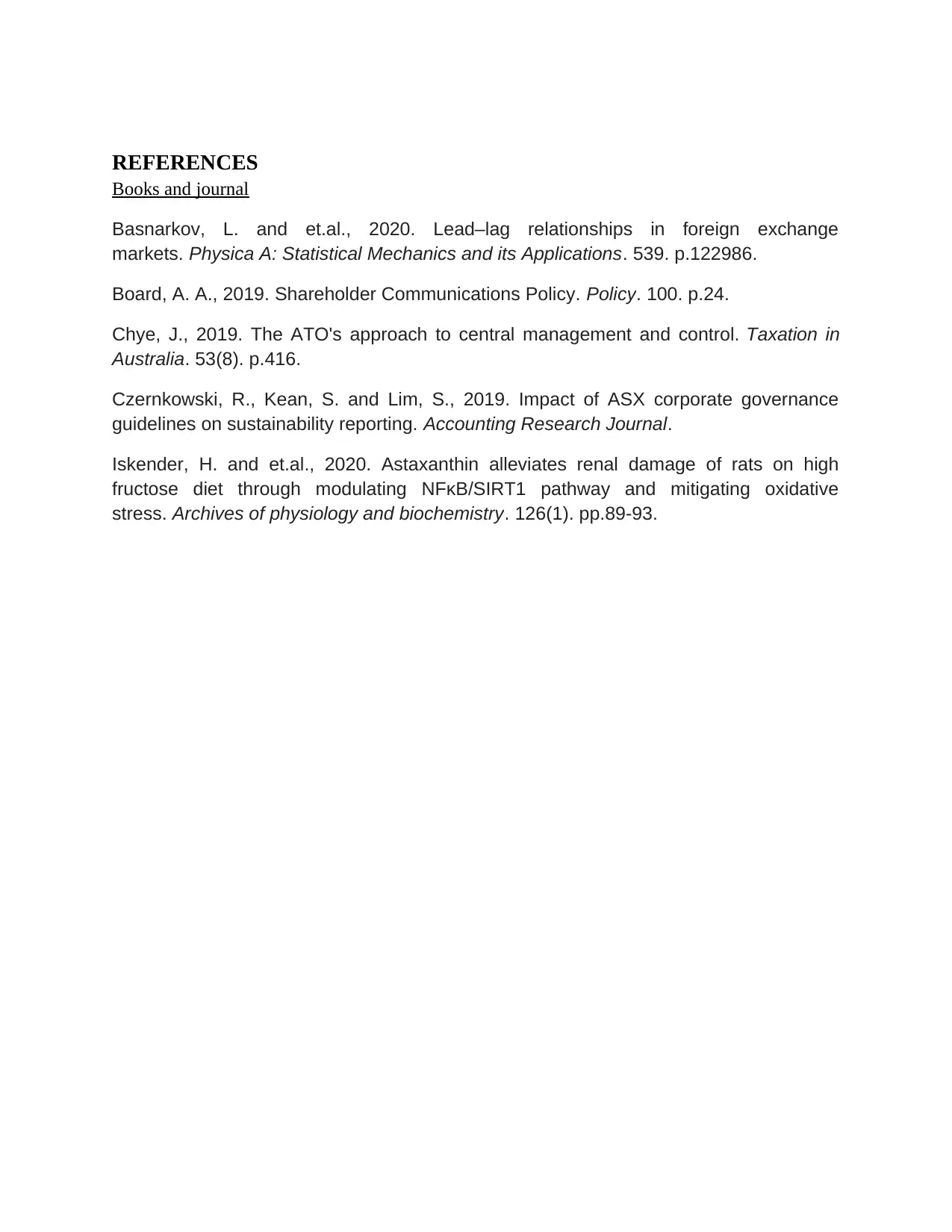
REFERENCES
Books and journal
Basnarkov, L. and et.al., 2020. Lead–lag relationships in foreign exchange
markets. Physica A: Statistical Mechanics and its Applications. 539. p.122986.
Board, A. A., 2019. Shareholder Communications Policy. Policy. 100. p.24.
Chye, J., 2019. The ATO's approach to central management and control. Taxation in
Australia. 53(8). p.416.
Czernkowski, R., Kean, S. and Lim, S., 2019. Impact of ASX corporate governance
guidelines on sustainability reporting. Accounting Research Journal.
Iskender, H. and et.al., 2020. Astaxanthin alleviates renal damage of rats on high
fructose diet through modulating NFκB/SIRT1 pathway and mitigating oxidative
stress. Archives of physiology and biochemistry. 126(1). pp.89-93.
Books and journal
Basnarkov, L. and et.al., 2020. Lead–lag relationships in foreign exchange
markets. Physica A: Statistical Mechanics and its Applications. 539. p.122986.
Board, A. A., 2019. Shareholder Communications Policy. Policy. 100. p.24.
Chye, J., 2019. The ATO's approach to central management and control. Taxation in
Australia. 53(8). p.416.
Czernkowski, R., Kean, S. and Lim, S., 2019. Impact of ASX corporate governance
guidelines on sustainability reporting. Accounting Research Journal.
Iskender, H. and et.al., 2020. Astaxanthin alleviates renal damage of rats on high
fructose diet through modulating NFκB/SIRT1 pathway and mitigating oxidative
stress. Archives of physiology and biochemistry. 126(1). pp.89-93.
1 out of 8
Related Documents
Your All-in-One AI-Powered Toolkit for Academic Success.
+13062052269
info@desklib.com
Available 24*7 on WhatsApp / Email
![[object Object]](/_next/static/media/star-bottom.7253800d.svg)
Unlock your academic potential
Copyright © 2020–2025 A2Z Services. All Rights Reserved. Developed and managed by ZUCOL.





